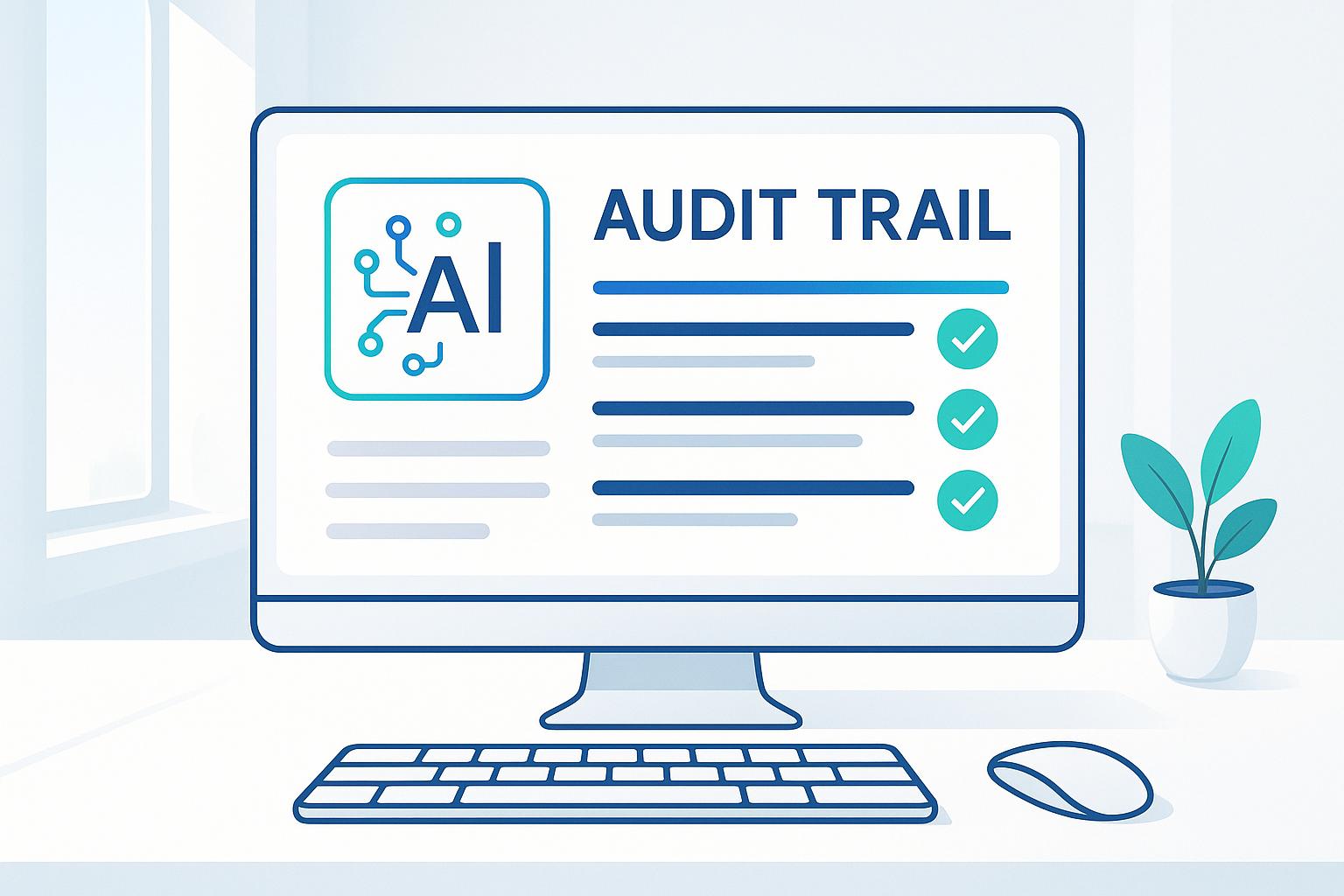AI is transforming how small and medium-sized businesses (SMBs) manage their finances. It automates repetitive tasks, improves forecasting accuracy, and provides real-time insights, saving SMBs time and money. Here's what you need to know:
-
Key Benefits:
- Time Savings: AI tools can save SMBs over 20 hours per month on financial tasks.
- Better Forecasting: AI analyzes historical data to predict revenue trends and minimize errors.
- Real-Time Insights: Syncs with financial systems for instant cash flow monitoring and scenario planning.
-
Getting Started:
- Choose tools that integrate with existing systems like QuickBooks.
- Train employees to use AI effectively.
- Address data accuracy and integration challenges.
AI Financial Tools for Small Business: Automate Accounting, Budgeting & Planning
Benefits of Using AI for SMB Financial Planning
AI is changing the way small and medium-sized businesses (SMBs) manage their finances, delivering clear advantages that directly affect their bottom line. Here's how AI tools are reshaping financial planning for SMBs.
Better Accuracy and Forecasting
AI minimizes human errors in financial planning while offering deeper insights through data analysis. By reviewing historical data, it identifies trends, predicts revenue patterns, and eliminates manual mistakes. Over time, these tools refine their projections, making forecasts increasingly precise.
"Clockwork's technology enables SMBs to save 20+ hours monthly on financial planning and forecasting" [1].
With these improved forecasting tools, SMBs can make decisions based on dependable data. Beyond just accurate predictions, AI empowers businesses to act on insights in real time, leading to smarter and quicker decisions.
Real-Time Data and Scenario Analysis
AI tools sync with financial systems to provide instant insights. This allows SMBs to monitor cash flow, evaluate different scenarios, and measure performance against industry benchmarks. For example, Lucid Financials integrates seamlessly with existing platforms, enabling businesses to adjust their financial strategies quickly.
SMBs can explore scenarios like the effects of hiring, marketing budgets, or pricing strategies. This helps them prepare for market changes and make decisions that save both time and money.
Time Savings and Cost Reduction
AI simplifies financial processes by automating repetitive tasks that typically require a lot of resources. Tools like BILL show how AI can handle data entry, invoice processing, and compliance tasks [4]. This allows SMBs to shift focus from manual work to growth-driven strategies, while maintaining accuracy in financial reporting and meeting regulatory standards.
Steps to Start Using AI for Financial Planning
Using AI tools can completely change how SMBs handle financial planning. The first step? Picking the right platform and integrating it effectively.
Choosing the Best AI Financial Tool
Finding the right tool means looking at how well it fits your needs. Does it work with your current systems like QuickBooks or payroll software? Does it offer features like scenario planning or industry benchmarks? Tools like Lucid Financials are great examples, as they check these boxes.
Look for platforms that grow with you. Flexible pricing and advanced features, such as those provided by Lucid Financials, can make scaling easier. Focus on tools that offer:
- Easy-to-use designs
- Real-time updates
- Automated planning options
- Industry benchmarks
Once you’ve chosen a tool, the next step is making sure it integrates smoothly into your workflow.
Integrating AI Tools into Your Financial Workflow
After picking your tool, the real work begins: integration. Start by cleaning up and organizing your financial data. This ensures accuracy when moving to the new system.
Next, invest in training your team. A well-prepared staff is crucial for getting the most out of your AI tool. Ongoing support systems can also make the transition smoother.
Here's a quick breakdown of how integration can look:
| Integration Component | Manual Approach | AI-Enhanced Approach | Impact |
|---|---|---|---|
| Data Migration | Manual entry | Automated syncing | Improved accuracy |
| Financial Reporting | Monthly updates | Real-time insights | Faster decisions |
| Scenario Planning | Spreadsheet-based | AI-driven analysis | Deeper insights |
To make sure everything works as expected, start with a pilot project. For example, Telemetry users have reported that their AI-enabled tool allows team members to ask financial questions in natural language, delivering complex answers in seconds [2].
sbb-itb-17e8ec9
Challenges in Adopting AI for SMBs
AI tools can transform financial planning, but small and medium-sized businesses (SMBs) often encounter obstacles when trying to implement these solutions. Tackling these issues head-on is key to successful adoption.
Fixing Data and Integration Problems
High-quality data is the backbone of effective AI use, yet 61% of SMBs face challenges with data integration [3]. To get the most out of AI, businesses need to ensure their data is accurate, consistent, and properly connected across systems.
| Challenge | Solution | Expected Outcome |
|---|---|---|
| Data Accuracy | Conduct regular audits | Fewer errors in AI-generated insights |
| System Integration | Use automated connections | Smooth data flow between platforms |
| Data Standardization | Implement unified formats | Reliable and consistent AI analysis |
Once these foundational issues are addressed, the focus can shift to equipping teams to work effectively with AI tools.
Training Teams to Use AI Tools
Training employees is another significant hurdle, with 55% of SMBs citing difficulties in staff training [3]. A well-thought-out training plan can make all the difference in adoption success:
- Start with the basics: Let employees practice core features hands-on.
- Address job security concerns: Highlight how AI supports, rather than replaces, their roles.
- Provide ongoing support: Offer continuous guidance to help team members grow their skills.
For instance, Clockwork users have reported saving over 20 hours a month on financial tasks after receiving proper training [1]. By clearly communicating how AI can streamline workloads and free up time for strategic priorities, teams are more likely to embrace these tools with confidence.
What's Next for AI in SMB Financial Planning
New Trends in AI Financial Tools
AI financial tools are advancing quickly, giving small and medium-sized businesses (SMBs) access to more powerful features. Key developments include predictive analytics and natural language processing, which are becoming standard in today's financial platforms.
For instance, Telemetry's AI Assistant allows team members to ask financial questions in plain language and get instant answers. Whether it's operating P&L details, budget comparisons, or customer insights, the tool simplifies access to complex financial data [2].
| Emerging AI Capability | Business Impact |
|---|---|
| Natural Language Queries | Quicker access to financial insights |
| Dynamic Forecasting | Better visibility into cash flow |
| Collaborative AI Systems | Improved team decision-making |
Natural language queries are now widely accessible, speeding up financial analysis. Dynamic forecasting, which gives businesses a clearer view of their cash flow, is expected to become mainstream by 2025. Tools like Lucid Financials already offer instant planning and scenario comparisons, integrating seamlessly with platforms like QuickBooks to provide enterprise-level insights.
These advancements mean SMBs need to adopt AI-driven strategies to remain competitive in a rapidly changing financial environment.
How SMBs Can Stay Ahead with AI
To make the most of these trends, SMBs should focus on using AI tools in practical ways that deliver real value. Here are some actionable steps to help businesses stay ahead:
- Start with integrated solutions: Choose AI tools that work smoothly with your current systems to ensure real-time data flow without major disruptions.
- Measure success with clear metrics: Track specific outcomes to assess whether the AI tools are delivering the expected benefits.
- Commit to ongoing learning: Regular updates and training sessions help teams stay up-to-date with new AI features and maximize their potential.
BILL's financial operations platform is a great example of how AI is becoming more automated and accessible [4].
"The integration of AI tools into financial management processes can help SMBs gain a competitive edge by enabling informed decision-making and strategic planning" [3].
As AI tools become more advanced, SMBs that embrace these technologies early will be better prepared to grow their operations and compete effectively in their industries.
Conclusion: AI as a Tool for SMB Growth
AI is reshaping how small and medium-sized businesses (SMBs) handle financial planning. With advanced tools now within reach, smaller businesses can operate more effectively and compete on a larger scale.
| Impact Area | Business Benefit | Real-World Application |
|---|---|---|
| Resource Optimization | Cuts manual tasks and costs by 70% | Automated forecasting and smoother operations |
| Decision Making | Real-time data analysis | Instant scenario planning and risk assessment |
Using these tools, SMBs can better position themselves to thrive in competitive markets. Take Lucid Financials, for example - it simplifies financial planning for SMBs with features like real-time insights and scenario comparisons.
For SMBs looking to stay ahead, it’s crucial to focus on tools that:
- Automate repetitive tasks while leaving room for human judgment in critical areas
- Deliver data-driven insights to improve forecasting and planning accuracy
- Support scalable financial processes as the business grows
"The integration of AI tools into financial management processes can help SMBs gain a competitive edge by enabling informed decision-making and strategic planning" [3].
As AI continues to advance with features like predictive analytics and natural language processing, SMBs should embrace these changes. These tools not only save time and cut costs but also turn financial planning into a strategic asset. Early adoption could mean stronger growth and a more competitive stance in the market.
FAQs
Will financial planners be replaced by AI?
With the rise of AI tools, many small and medium-sized businesses (SMBs) are asking if human financial planners will become obsolete. The short answer? No. AI enhances financial planning but doesn’t replace the expertise humans bring to the table.
| Role | AI Tools | Human Planners |
|---|---|---|
| Analysis | Processes data and identifies patterns | Offers strategic guidance and context |
| Client Focus | Handles calculations and reporting | Understands specific business needs |
| Decision Making | Provides real-time insights and forecasts | Develops complex strategies |
For SMBs, this partnership is especially beneficial. AI takes care of data-heavy tasks and routine processes, while financial planners focus on crafting strategies tailored to the unique needs and challenges of each business.
Key benefits of combining AI and human expertise:
- AI processes large datasets to deliver precise insights, while humans interpret these insights strategically.
- Automating repetitive tasks frees up planners to concentrate on growth-focused strategies.
- The blend of technology and human expertise leads to stronger business outcomes.
Telemetry's AI Assistant is a great example of this collaboration. It gives SMBs instant access to financial insights while ensuring human planners remain central to strategic decision-making [2]. This balance is particularly important for smaller businesses, where every resource must be used effectively.
"Financial visibility breeds accountability, and accountability breeds better financial results" [2]
Financial planning often involves emotional and situational complexities that AI alone cannot address. The future of financial planning for SMBs lies in combining AI’s efficiency with the human ability to make nuanced decisions and think strategically [3].
This partnership between AI and human expertise is shaping a smarter approach to financial planning, helping SMBs grow with well-informed strategies.


